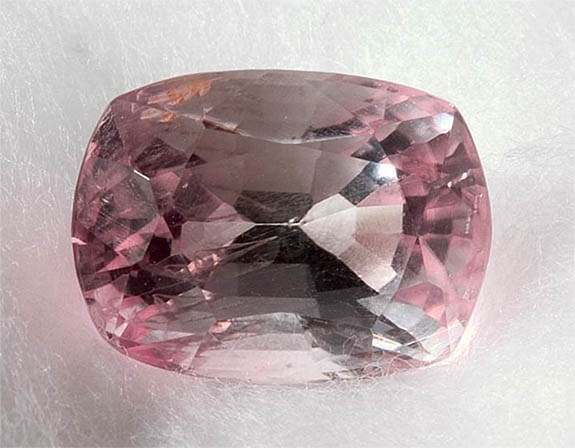August 23rd, 2021
Today starts an occasional series covering the rarest gems you've probably never heard of. The remarkable 9.41-carat light-pink oval gem seen here is one of the largest — if not the largest — faceted poudretteite in existence, according to the Smithsonian.

A faceted poudretteite is so rare, says the Gemological Institute of America (GIA), that few professional gemologists will ever encounter one.
Poudretteite gets its name from the Poudrette family, owners and operators of a quarry near Mont Saint-Hilaire, Quebec, Canada, where a few tiny crystals of the curious material was first unearthed in the mid-1960s. It would take until 1986 for poudretteite to finally be recognized and registered as a new mineral.
In 2000, the first documented gem-quality specimen of poudretteite was discovered nearly half-a-world away in Mogok, Burma — an area famous for its pigeon's blood rubies, as well as lapis lazuli, garnet, moonstone, amethyst, peridot and chrysoberyl. The 3-carat poudretteite was submitted to the Gubelin Gem Lab for examination, and the findings were published in the scholarly journal Gems & Gemology in 2003.
Also sourced in Burma, the much larger, nearly flawless 9.41-carat poudretteite is the only gem of its kind in the Smithsonian's National Gem Collection. The gem was generously gifted to the Smithsonian in 2007 by Frances Miller Seay.
Poudretteite can range from colorless to purple-pink and owes its color to the presence of manganese in its chemical composition. Specimens with few inclusions and saturated color are said to be worth $6,000 per carat or more.
On the Mohs hardness scale, poudretteite rates a 5, compared to amethyst (7), topaz (8), sapphire (9) and diamond (10). The relative softness of the gem makes it unsuitable to be used in a ring, but it could be used, with care, in earrings, a pendant or pin.
Credit: Photo by Ken Larsen / Smithsonian.

A faceted poudretteite is so rare, says the Gemological Institute of America (GIA), that few professional gemologists will ever encounter one.
Poudretteite gets its name from the Poudrette family, owners and operators of a quarry near Mont Saint-Hilaire, Quebec, Canada, where a few tiny crystals of the curious material was first unearthed in the mid-1960s. It would take until 1986 for poudretteite to finally be recognized and registered as a new mineral.
In 2000, the first documented gem-quality specimen of poudretteite was discovered nearly half-a-world away in Mogok, Burma — an area famous for its pigeon's blood rubies, as well as lapis lazuli, garnet, moonstone, amethyst, peridot and chrysoberyl. The 3-carat poudretteite was submitted to the Gubelin Gem Lab for examination, and the findings were published in the scholarly journal Gems & Gemology in 2003.
Also sourced in Burma, the much larger, nearly flawless 9.41-carat poudretteite is the only gem of its kind in the Smithsonian's National Gem Collection. The gem was generously gifted to the Smithsonian in 2007 by Frances Miller Seay.
Poudretteite can range from colorless to purple-pink and owes its color to the presence of manganese in its chemical composition. Specimens with few inclusions and saturated color are said to be worth $6,000 per carat or more.
On the Mohs hardness scale, poudretteite rates a 5, compared to amethyst (7), topaz (8), sapphire (9) and diamond (10). The relative softness of the gem makes it unsuitable to be used in a ring, but it could be used, with care, in earrings, a pendant or pin.
Credit: Photo by Ken Larsen / Smithsonian.



